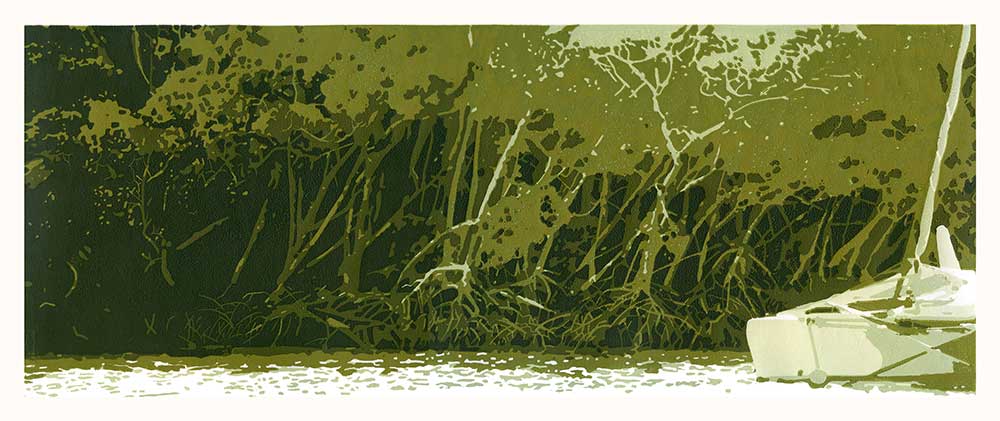Part 3: Editioning Fine Art Prints

In this final of 3 articles you can read about how to edition printmaking prints. Understanding this is essential to signing and editioning your own work; and also understanding the value of a print your are observing.
Printmaking prints are original fine art artworks, even though they may form ‘editions’ or be produced in ‘multiple’. Understanding the different ways to edition prints will help you understand and better appreciate the nature of this artform.
Signatures
Very early prints were not signed. In the later part of the fifteenth century many artists signed their prints by incorporating a signature or monogram into the design as ’signed in the plate’ or ’plate signature.’
While some prints were pencil signed as early as the late eighteenth century, the practice of signing work in pencil or ink did not become common practice until the late 1880s, probably coinciding with the practice of numbering editions.
Signing a print as initially done for the benefit of collectors; artists and publishers, when presented with a choice, preferred to buy pencil-signed impressions rather than an unsigned print.
Today it is expected that original prints be signed by the artist. An unsigned impression of the same print is generally not as commercially valuable.
Number and Editioning
Numbering printed editions didn’t start until the late nineteenth century. However, it wasn’t a standard practice until the mid 1960s. Today, all limited edition prints should be numbered, with the first number being the impression number and the second number representing the whole edition. For example 3/10, where 3 is the 3rd impressions from and edition of 10 prints. The numbering sequence does not necessarily reflect the order of printing; prints are not numbered as they come off the press but some time later, after the ink has dried. The edition number does not include proofs, but only the total in the numbered edition.
If you are not sure how to edition printmaking prints, you are not alone. As you read on you will see many different edition types. Some of these I hadn’t heard of until I started to write this article.
So how to edition printmaking prints …
Edition Variable – EV
With an EV print, the impression may be printed then hand coloured, or printed onto different papers, or combined with a Chine collé collaged through the press. Essentially, each print within the ‘edition’ is different to the other.
When annotating an Edition Variable print, the artist will use “EV 1/X” where X is the total number of impressions in the edition.
Open Edition – O or OE
If you want to print an image, but it is not to be a Limited Edition, but rather an impression from a plate that you intend to print multiple times, you can annotate it as an Open Edition. Annotating an Open Edition print, I would use “OE1”, where the number is the number printed to date for the open edition, but with no need for the total edition number . ie “/X”. And combine that with an Open Edition Variable and you get “OEV 1”.
Artist Proof – AP
Historically, when an artist was commissioned to execute a print, they were given with accommodation and living expenses, a printing studio and workmen, supplies and paper. The artist was given a portion of the edition (to sell) as payment for his work – these were the Artist Proofs. By today’s standards they are named such to denote a certain number of impressions put aside for the artist to do with as they will. When annotating an Artist proof, use “AP 1/X” where X is the total number of Artist Proofs. They can also be numbered Epreuve d’artiste or EA. The number of Artist proofs should generally not exceed 10% of the total number of the edition.
Trial Proof – TP
A working proof pulled before the edition to see what the print looks like at a stage of development, which differs from the edition. There can be any number of trial proofs, but usually it is a small number and each one differs from the others. When annotating a Trial proof, “TP 1/X” where X is the total number of Trial Proofs.
Bon a Tirer Proof – BAT
Literally, the “okay-to-print” proof. If the artist is not printing his own edition, the bon a tirer is the final trial proof, the one that the artist has approved, telling the printer that this is the way he wants the edition to look. There is only one of these proofs for an edition and can be accompanied by printing notes (paper, ink or inking process) to be used as a reference for the printing of the whole edition.
Printers Proof – PP
A complimentary copy of the print given to the publisher. There can be one or several of these proofs, depending on how many printers were involved in the production of the print. When annotating a Printers proof, use “PP 1/X” where X is the total number of Printers Proofs.
Hors de Commerce – HC
Prints annotated HC (Hors de Commerce) are “not for sale”. These “proofs” started to appear as extensions of editions being printed in the late 1960s. They may differ from the edition by being printed on a different paper or with a variant inking; they may also not differ at all. Publishers may sometimes use such impressions as exhibition copies, thereby preserving the numbered impressions from rough usage. When annotating an Hors de Commerce proof, use “HC 1/X” where X is the total number of Hors de Commerce Proofs.
I hope this has helped you with understanding how to edition printmaking prints. If you think I have missed anything, please add it to the comments below.
Recap what was previously covered?
Go back to read Part 1: What is Printmaking?
Go back to read Part 2: The Art of Printmaking






Hello,
I have a question since I’m quite new to printmaking.
If I make an edition of for example 50 of one of my linocuts with black ink on paper type X and then later I want to do another edition of for example green ink on paper type Y. Is that ok? Can I make multiple limited editions if the same linocut but in different variants? How would I number it correctly?
Thank you in advance
Hi Katrin, good question! I have done a few prints like this – 1x was an etching that I printed a limited on to 2x different papers. I researched it at the time and couldn’t find much about how to edition them. From what I was able to find I ended up editioning them as 2x separate editions. Paper X was one limited edition and paper Y another. The other 2x were prints in this situation were reduction linocut prints that I printed each on 2x different papers – and I kept the editioning/number in the same limited edition of 10 prints, but annotated them as 1/10s, 2/10s, 3/10s … 8/10h, 9/10h, 10/10h – where the ‘s’ and ‘h’ was the initial of the paper I used. I don’t know if that was the correct way to do it or not, but it was the only way I could see to identify them. I guess I could have editioned all of them as 1/10EV, 2/10EV etc.. With all my prints, when I sell them, I include information about the print and edition, so for those reduction prints I added notes about the different papers used in the edition. Its difficult to find specific and ‘correct’ information about some of the editioning variables. I research, then use my best judgement to make the final decision. I hope that helps 🙂
That’s such useful information Kim. I’m currently editioning a set of 12 linocuts for an exhibition and I’m having problems with my elbows so I decided to print using my etching press and heavier weight paper but I really prefer to print by hand on Japanese paper so I want to go back to that when I have more time. Knowing that it’s a known ‘thing’ to have varied papers across the edition and that I can call it an EV (or VE here in UK) is reassuring. I much prefer the meditative hand burnishing and I like the fact you can vary the pressure but it is pretty time consuming and my elbows can’t take too much.
Hi Hester, happy you found this helpful 🙂 I’m with you on the hand burnishing. I enjoy that. But for me 30 years of bad posture at a computer is catching up with me and I’m finding it harder. I’ll be using my press for lino more and more I think. Happy printing. cheers, Kim 🙂
Thank you, Kim. I’ve found this very helpful as I’ve started doing some chine colle and wasn’t sure how to handle editioning them. I’ll do them as EVs, or VEs which I’ve used in the past for different ink colours (I think we tend to use VE in Britain to denote variable edition).
Best wishes
Aileen
Thanks Aileen. I love to hear that Ive written something that was helpful for someone 🙂 Happy 2020!
Thank you for the information. I print using archival pigments/ink on archival paper printed at different sizes; A3, A2 and A1. To distinguish the different paper sizes I am using as a preface to the edition then sequence the print run. For example; A3 1/20, A2 1/10 and A1 1/5. Is this OK as it indicates the larger paper sizes have smaller print runs and thus fetch higher prices for the larger surfaces. I sometimes like to convert some images to black and white, usually square prints of one size. For these, I’m planning on a different sequence; e.g., EV B&W 1/20. This makes sense to me, but not sure if this is confusing to others or if it is breaking some sort of convention.
Hi Glenn, that sounds ok for me. I’m not an expert when it comes to creating those sort of variations, but I have done something similar. I have printed the same reduction linocut image on 2 different papers, so I editioned them as X/10(s) and Y/10(h) – where X was #s 1-5 and Y was #s 6-10. Does that make sense?? From the research I did at that time, printing on the different papers made for different editions. It can get very confusing. If you were printing the same image colour vs b/w, personally I’d be inclined to edition them totally separately, but I dont think there is anything wrong with the way you’re thinking.
Thank you for the information on editions – very helpful to direct folks to – and your website is lovely – cheers!
Hi Leigh, thank you 🙂 I figure the more we all share, the better educated people become and the higher the profile of printmaking. Kim 🙂
Hello Kim, thank you so much for your article : it’s the most complete I have read so far ! Still, I have a question, not sure if it’s even an option… Let’s put it this way : I realize some 30 prints from the same block but among them, 8 are not “perfect” to me. It’s not big deal, just some intrusive spots of ink here and there. I’ve already seen printmakers selling their imperfect prints at a lower price. That’s okay with me, but still, I can’t figure out how to edition them ! I think they are called “second prints” in english (I am French, excuse my poor english by the way!) : Do you think “SP (for second print) 1/8 could do it ? Thank you again !
Hi Moira, great question that I don’t have a specific answer to. I don’t include all prints in my final edition. If I think one or some are less than perfect (for me), then I’ll not edition it and keep it aside to use as, or for, something else (collage, book cover, cards). That said, there are some prints I deemed as “less than perfect”, looked back on them months later and regretted being too hard on myself. The process isn’t perfect. I’ve not heard of a ‘second print’ edition, but as long as there is a clear explanation as to why they are different from the edition, it could work. Although I would guess it probably isn’t the most appropriate way to edition them. I’m really not sure about that one. It may be worth finding a lecturer/teacher at art school in Printmaking to help answer that question. I’m sorry I’ve not been able to answer you properly. cheers, Kim ps. your English is perfect! I can speak maybe 6 words in French. I admire anyone who can speak and write a second language 🙂
I will be selling a small number of reproductions of my pencil drawings. I would like to make them a limited edition, to start with, because I have no idea how this is going to go. However, I want to have the opportunity to make a “2nd run” if this whole thing goes better than expected. Along with the 1/x, 2/x etc, I think there should be some way of indicating which are from the 1st printing and which are from the 2nd printing, but I have not been able to find anywhere that tells me how to do that.
Hi Janet, I have seen reference somewhere of someone editioning in a ‘reprint’ type situation, but I cant remember who or where. Reprinting an already editioned limited edition will effect the the value and integrity of the first edition. My approach would be to either decide now the total limited edition size (example 100) and print a small number to test sales (example 10), editioning them as 1/100 etc.. If you don’t sell the 10, you can decide to not print the others. If you do, reprint as needed and edition accordingly. OR print them as a signed Open Edition, so you can keep printing and sell for as long as you like. Remember that a ‘Limited Edition’ is special because it is ‘Limited’. I hope that helps??? cheers, Kim 🙂
Hi Kim
I appreciate all your insights and the comments from others. I have a question for you. I made an edition (of 5) in one colour and then decided to make an edition (of 5) in a different colour. How to name them? I thought to give them the same title with I or II after the title. What do you think? Do you have another suggestion? Thanks
Hi Hilary, I did something similar about 8 years ago – where I used different papers. I don’t know if what I did was traditionally or technically correct. I printed a limited edition reduction lincut on 2x different papers – Stonehenge and Hosho. I kept the title the same and editioned 1-5 of the 10 as 1/10s, 1/10,s, etc, then 6-10 of the 10 as 6/10h, 7/10h, etc.. The ‘s’ and ‘h’ denoted the paper. I had read at the time that they could have been editioned as two different editions, because of the paper, but I didn’t want to change the title. If it is the colour of the printed image that is different I think you could consider them as 2 separate editions, differentiating the title, or one edition variable – keeping the same title. Personally I don’t like using I and II etc after titles – but that is a very personal thing for me, not right or wrong. I have used them on occasion, but try to avoid them. I’m not sure if I’ve been helpful or not??? I hope so 🙂 Thank you for visiting and reading my post 🙂 Kim x
Hi.
How would you sign a one-off lino print? I have just produced a commission where only one print was made that will be kept.
Joanna
Hi Joanna, absolutely sign your artwork, your print. If I print a one-off linocut print I ‘edition’ it as 1/1. Congratulations on the commission. cheers, Kim 🙂
Hello,
I have revised the plate for a linocut and will be producing an edition from this second state of the plate. I understand that states are customarily represented by roman numerals, so this will be state #2 represented as II. But how is the state number actually incorporated into the numbering system written in the lower left corner of the print? I find it mentioned often to use roman numerals, but no examples of how it is added to the numbering system. Is the word “state” written out or abbreviated or is just the roman numeral used? And does that precede or follow the 00/00 number? Any other info I should be aware of? Many thanks.
Anne
Hi Anne, to be completely honest, I don’t know. If you do find reference to it somewhere, please share it back here. Did you create an edition with the first state of the plate?
Yes, well, not completely. I started an edition and sold a few, but then discovered what I felt was an error and never completed the edition. I have revised the print to remove the error and want to do a full edition, and I think the changes I have made are substantial enough to warrant labeling it as a second state.
Perfect 🙂